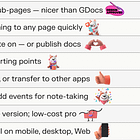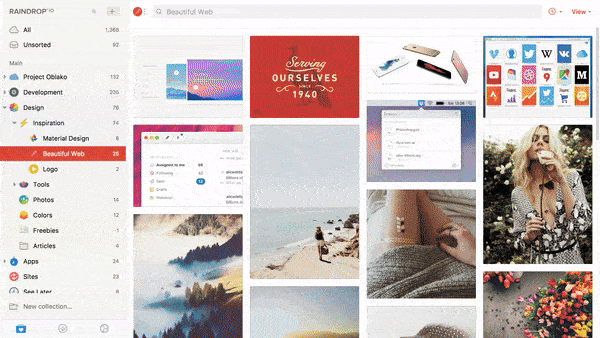My Favorite Link Organizer 🔗
A free tool to tame bookmark chaos
Raindrop is the most useful, best designed tool for saving and organizing links. Having saved thousands of bookmarks over the years, I’ve tried various systems for filing. These days Raindrop is what I use for keeping track of research, new sites, and collections of links I intend to share with friends, colleagues and readers. Read on for its best features, creative ways to use it, and alternatives.
Raindrop’s best features
1. Easy and free on any platform
Download the Raindrop app for Mac, Windows, Linux, iOS, Android, or any browser. Read its FAQ. Once you’ve installed the browser extension, it’s easy to save a link to any Web page and optionally add a note or tag for future reference. Bookmarks can have as many tags as you’d like for easy searching. Links can also be placed into a collection, which is basically a folder. New features pop up frequently.
Pricing: I recommend the free plan, which allows for unlimited links, collections, highlights, devices, public sharing, collaboration, and integrations. It has the primary features most people need and there’s no pressure to pay.
Pro: The $3/month option ($28/annual) adds a few fancy features, including:
Find duplicate or broken links in your collection
Search the text of all sites you save
Preserve automatic copies of each Web page you save in case the original site goes offline
Upload 10GB of files each month to store your own files, images, PDFs, videos, etc.
Sponsored Message
🎥 Guidde | Create how-to guides with AI
Tired of explaining the same thing over and over again to your colleagues?
Guidde is an AI-powered tool that helps you explain the most complex tasks in seconds with AI-generated documentation.
Turn boring documentation into stunning visual guides
Save valuable time by creating video documentation 11x faster
Share or embed your guide anywhere
Just click capture on the browser extension. The app will automatically generate step-by-step video guides complete with visuals, voiceover and call to action.
The best part? The extension is 100% free.
2. Share links and collaborate on collections
All your link collections are private, and you can share them at will. Display your links in a list, as cards in a gallery, or as a visual mood board.
Add collaborators to a collection for a team or family project.
Publish collections of links that anyone can freely access without needing to use Raindrop or to sign up or register.
Embed link collections to host them on a website.
Examples: Public link collections I’ve saved
Revenue streams. A curated collection of ways niche journalism ventures make money.
Online events platforms. A pandemic-era catalog of the flurry of apps that launched to help people gather online.
3. Use AI to assist with organizing your links
A new AI organization tool helps with organizing your links. It will suggest a collection or tag for unsorted bookmarks, or a tag. That's especially helpful if, like me, you sometimes forget to tag or file what you save.
4. Integrations: Automatically sync links across platforms
You can connect Raindrop to any of 2600 other services so you can access links you’ve saved later wherever and however you need them.
Raindrop can log links automatically to a Google spreadsheet or a Notion page. You don’t have to manually add them.
Sync links you save in Raindrop to Readwise or Instapaper for reading later. You can also import links from those services to Raindrop.
Raindrop works well with automation apps like IFTTT and Make (though not
Zapier. (Here’s why I find IFTTT useful). Pairing one of those apps with Raindrop lets it automatically collect links you interact with on other services. You can use that capability to:Collect links to the songs you favorite on Spotify to a Raindrop collection.
Save social media posts of interest to a project folder on Raindrop.
Keep track of videos you like on YouTube.
5. Export and import
It’s easy to import and export links with Raindrop.
Export: Instead of dumping out your whole treasury of links, you can export just a relevant batch of links with a particular tag. Or export a link collection (folder). You can export the links as a CSV file for a spreadsheet, as an HTML file, or as text. Or you can always share a group of links with a simple link.
Import: Import links you’ve saved easily from other services. Bring in links you’ve saved to browser, Evernote, or apps like Diigo, Dropmark, Goodlinks, etc.
💡 Suggested ways to use Raindrop
📁 Organize project research
Park project materials in a Raindrop collection as you conduct research online. Save links into a neat Raindrop collection rather than printing out piles of paper or stuffing links into Word or Google Docs. You can even annotate links as you go. It’s a simple, free, fast way to create a private or shared digital project file box.
🧶 Gather and collaborate on hobbies
Use it to gather links with friends. If you're part of a club, team, hobby or fan group, you can collectively drop in your favorite links, with or without annotations.
👩💻 Share resources for a presentation or workshop
If you teach or give talks, Raindrop is useful for sharing your list of links or resources. Share a single link to a collection you host on Raindrop. Attendees will then be able to see all your materials in one spot, including all your links, videos, and a PDF of your slides or handouts.
Note: Raindrop works well when you’re mainly sharing links and want to keep things simple. But I usually prefer Craft for creating digital handouts I share after presentations, because it allows me to share a more visual resource, not just a list of links. For further context, see my recent post about why Craft is my favorite all-around productivity tool.
🎨 Create a mood board
For planning an event, party, or a renovation, Raindrop can be useful for saving inspiring images or links. The mood board layout option gives you a nice visual view of your links with cover images. It also automatically pulls in the description from any link you save.
Caveats
Packrats beware. As someone who saves more than I find time to consume, I confess to a digital packrat tendency. Adding yet another storage hub like this can lead you to overwhelm yourself with an avalanche of saved stuff that you lack time to review.
Avoid duplicate hubs. No need to add another digital sock drawer if your organization system already works well. If you have a well-established system in Notion, Coda, Airtable, Obsidian or somewhere else, stick to what’s working. Those platforms allow you to create your own custom organizational structure with advanced filtering.
Mobile app visuals. Images in articles saved to Raindrop — particularly in paywall publications like the NYTimes — may not show all show when you read on the mobile app. I prefer to read saved articles in Readwise Reader.
Tiny team. Raindrop was envisioned, built, and managed by one person - Rustem Mussabekov, a 🇰🇿 Kazakhstan-based designer/developer. It’s been around for more than a decade, but its progress relies heavily on Rustem.
Useful Raindrop Alternatives
MyMind is a much more visually appealing visual storage hub for creating a visual scrapbook. Here’s why I find it useful. But it doesn’t allow for sharing.
Readwise Reader is my preferred app for catching up with online reading on the subway or airplane. (Why I like it). If you’re mostly saving reading material, Readwise is well-designed for both online & offline reading & highlighting. Tip: It’s also good for watching + highlighting YouTube videos.
Instapaper and Matter are also good options specifically designed for saving articles to read later, though none are ideal if you’re saving other kinds of links, like product pages or images.
Eagle is great for saving and organizing images and screenshots. Here’s what I like about Eagle.






Thank you Jeremy for another very useful post.
Undoubtedly Raindrop is an excellent cross-platform bookmarking tool with a very generous free plan. I would not hesitate to recommend it as well, even though it is not my tool of choice on this front.
At this time my preferred apps on this front are:
a) Capacities.io - which offers powerful database functionalities, customization and access across web and Mac/PC and mobile. It's a tad more techy and requires some learning to extract its advanced abilities, but it can be very useful when wanting to collect different type of resources and have specific records and fields for each type.
b) Sublime.app - for collecting ideas, inspirational stuff, notes, tweets, quotes and other material for thinking / writing / curating is truly a breeze of fresh air. While still in its first year of life it shows a unique character and spirit which make it the one of a kind tool for thinkers, writers and sense-makers of all religions.
Did you get to try them?
Any thoughts from your precious viewpoint are always very welcome.
I have paired Raindrop with Glasp and it's been wonderful. RD helps me keep things for later; on Glasp, I keep the highlights. Then, I can use the information to write articles or put projects together.